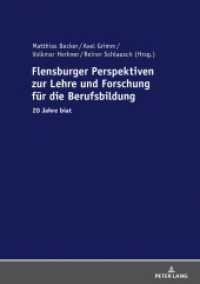- ホーム
- > 洋書
- > ドイツ書
- > Humanities, Arts & Music
- > Arts
- > history of arts
Description
(Text)
For a number of years now, art historians discuss the idea of East Central Europe as an artistic region. One of the most convincing - and pragmatic - answers has been given by Steven Mansbach: He strikingly demonstrated that from the Fin-de-siècle to the beginning of World War I the region From the Baltic to Balkans constituted a coherent and interactive art-historical meso-region characterized by specific national art traditions and innovations.
Steven Mansbach stresses in the tradition of his own discipline the overwhelming importance of urban centers in his predominantly rural "Eastern Europe". It is cities which shape artistic regions, and this the more so in a part of Europe where there are fewer cities than in other parts. This is one of the reasons why Mansbach in his 2013 Oskar Halecki Lecture analyzes (and visualizes) the "capital modernism" of the only "Baltic metropolis" - Latvia's capital Riga.
In looking at Riga's central role not only for Latvia but for all three Baltic countries and the wider Baltic Sea Region, Mansbach aptly applies Klaus Zernack's post-Haleckian meso-regional concept of "Nordosteuropa" which constructs a 'Mediterranean of the North' reaching from the Neva to the Kattegat - a region of enhanced economic, military, cultural, political, and ethnic cooperation and conflict from the Nordic Wars of the early modern period to the interwar years of the 20th century. As Mansbach demonstrates with the example of the city on the Daugava's modernism, after Hanseatic commercialism, Russian imperialism and Latvian nationalism also Soviet communism left its visible impact resulting in "a novel eclecticism" by "a quixotic intermingling of Riga's inventive modernism and constraining Soviet politics." Northeastern Europe lives on, and the Soviet legacy, unwelcome as it may be today, is a constituent part of it - as can be seen in Riga.
(Author portrait)
Steven A. Mansbach, Professor of the History of Twentieth-century Art at the University of Maryland in College Park, MD (USA), focuses his research and teaching interests on the genesis and reception of "classical" modern art from the last quarter of the nineteenth century through the middle of the twentieth. With interests that encompass all of Europe, his specific area of scholarly publication is the art of Central and Eastern Europe - from the Baltic north to the Adriatic south. On this topic he has published numerous books, articles, exhibition catalogues, and essays.








